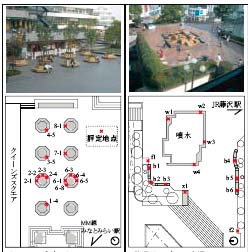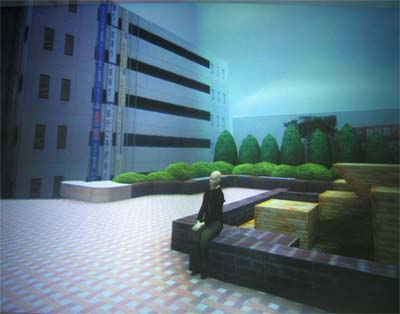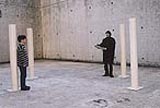 Seat preference in public squares and distribution of the surrounding people:
Seat preference in public squares and distribution of the surrounding people:
An examination of the validity of using visual simulation |
| <7th EAEA Conference, Dortmund, Germany, 2005> |
|
Ryuzo Ohno, Masashi Soeda, Kondo Yoshihisa, Naoki Hashimoto and Makoto Sato
|

 |
When people choose seats in a public square, they unconsciously evaluate not only the physical characteristics of the square but also
the spatial distribution of others already present. This study investigates the classic question of "personal space"—i.e., the spatial component of interpersonal
relations—employing a visual simulation system. The validity of using visual simulation was first examined, following which quantitative relationships
were obtained between subjects’ evaluations of seat positions and such geometrical values as the distance and angle between the seat and others already in the square.
Full paper → PDF file
|
|
 A Study of the Perception of Occupied Area in the Public Space
A Study of the Perception of Occupied Area in the Public Space
|
|
<Journal of Architecture, Planning and Environmental Engineering, No.519,
Pp.93-100, May. 1999>
Ryuzo Ohno, Yoshiharu Matsuda
|
|


|
People's behavior in a public space is affected by perceived personal
spaces of other people. This study investigated the influence on this perception of the other
people's various positional relationship with such subspace
establishing elements as walls and columns . Full-size experiments demonstrated that there is a
perceived occupied space around a person, depending on the position of that
person in relationship to walls or columns, and that the boundary of this
space is rarely crossed. A second experiment with a scale model of the same
previous spatial arrangements was conducted, as a means of discovering the
extent of these perceived personal space, by the subjects' use of such words
as "aside", "between" and "inside". Thus, the
areas expressed by these words were used to predict the boundary of space that
the subjects rarely go into, i.e. the perceived occupied area.
|
|
 The
Effects of Time-Varying Situations on Behavior in Meeting Places The
Effects of Time-Varying Situations on Behavior in Meeting Places
|
|
<Proceedings of MERA 97: International Conference on Environment-Behavior Studies for 21st Century, Pp.485-490, 1997.11>
Miki Kobayashi, Noriko SEKIMOTO, Ryuzo OHNO
|
|

|
The purpose of this paper is to clarify by objective time-based notation how an environment which changes with time influence behavior. More particularly, this research deals with how behavior in the meeting place is affected by both time and the physical environment. At two popular meeting places in downtown Tokyo, a person's motion was recorded by three TV cameras set in different positions. The movement of each person who answered our interview after rendezvous was studied on the video tape. Items of interview included promised time to meet, description used to specify meeting place, and the experiences of using the place, which we call "initial information". Based on observation of physical arrangements and people's distribution, several contour maps were created to show the level of "local potential" in the meeting place for three basic desires: comfortableness (refuge), easiness to find (prospect), easiness to be found (retreat/reveal). The person's movement trace was overlaid on these maps to describe a series of position choices which reflect varying mental states, or the priority of three basic desires. An analysis of behavior using the notation revealed that, (1)such initial information as specified position and expected direction of approach influence behavior while waiting; (2)different spatial arrangement of the meeting place influences position choice for having good visibility; (3) in crowded situations the desire to be found seem to be growing as time passed. Finally, we proposed implications for the design of meeting places considering temporal, spatial, and psychological factors. |
| Full paper → PDF file |
|
|
 Environment-Behavior System in the Case of Seating in Public Space
Environment-Behavior System in the Case of Seating in Public Space
|
|
<Summaries of Technical Paper of Annual Meeting of Architectural Institute of Japan (D-1), Pp.685- 688, Aug. 1995>
Yasuhiro Abe, Tukasa Hayashi, Ryuzo Ohno
|
|


|
Part1: Quantification and visualization of the environmental
conditions
This study is to clarify the relations between human-behavior and various environmental
conditions, more particularly, it investigated the seating behavior in
public space. A personal computer program which visually shows such quality of an exterior
space as view, pedestrian flow and seat surfaces was created. It was applied
to some urban small parks where a survey investigating seating behavior was conducted.
It is found that people's choice of the place depends on environmental
conditions and the their purpose of visiting the park. |
|